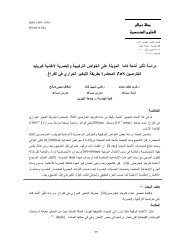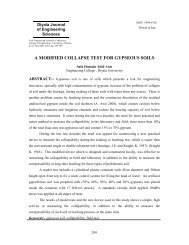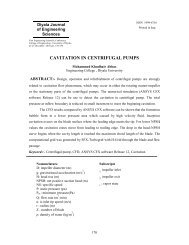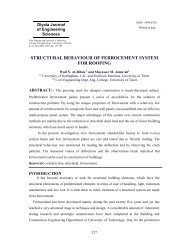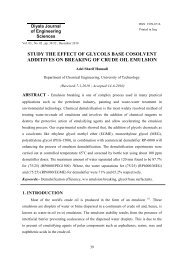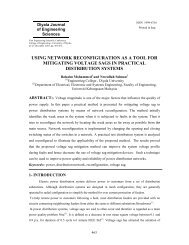Fulltext - Iraq Academic Scientific Journals
Fulltext - Iraq Academic Scientific Journals
Fulltext - Iraq Academic Scientific Journals
- No tags were found...
You also want an ePaper? Increase the reach of your titles
YUMPU automatically turns print PDFs into web optimized ePapers that Google loves.
First Engineering <strong>Scientific</strong> Conference-College of Engineering –University of Diyala, 22-23 Dec. 2010RANDOMLY MINING OF RIVER DEPOSITS AT AL-MANSURIAH DISTRICT AND IT'S EFFECTSON ENVIRONMENT AND ECONOMYGEOLOGY AND GEOMORPHOLOGY OF STUDY AREAThere is no outcrop of bed or rocks appear on the surface at lower Diyala basin, thealluvial sediments deposits, are loosely compact and composed of pebbles at the channel bedand mixed of sand, silt and clay. At the banks the thicknesses of sediments are more than 70meters, detected from ground water drilling. These sediments are of Quaternary age,(Buday, 1980).At the beginning of lower Diyala basin near the wire, the wide of the river ischangeable, from 380 meters at the wire to 250 meters at a distance of 15 kilometers downstream. The river profile has slop of about 1.4 m/km until about 5-6 km below the wire,where the river soon enters the friable soils of the plain in which the regime slope appears tobe only 10 cm/km,(AL-Aansari and AL-Jabbari, 1987). Diyala River from the weir tillconfluence with the Tigris River, Southern Baghdad, flow in vegetative area, which isplanted by diffrint types of fruits. These field fruits are irrigated by Al-Khalis and Almushtriccanals or irrigated by using pumping method either from Diyala River or fromunder ground wells.RIVER DEPOSITSGravel deposits, represent the local accumulations of channel fillings, and riverterraces Stream deposits are the most common and generally most desirable because:Individual pieces are usually rounded;Streams exercise a sorting action which may improve grading; and 3) abration causedby stream transportation and deposition leads to a partial elimination of weaker materials,(Hilf, 1978). A gravel deposit consists of a frame works of pebbles between which are voids.The voids are rarely empty, being occupied by sand, silt or clay material. Clay also may forma coating about pebbles, surface coating generally reduce the value of gravels as concreteaggregate, this and/or soft and loosely adhering surface coatings are particularly suspect. Clayand gypsum coatings, however, can often be removed by screening and washing. The shapeand surface texture of the pebbles in a gravel deposits are influenced by the agent responsiblefor its transportation and the time taken in transport, although the shape is depends on theinitial shape of the fragment which in turn is controlled by the fractures pattern within theparental rock. Gravel particles can by classified as rounded, irregular, angular, flaky andelongated (Bell, 2007).Diyala Journal of Engineering Sciences – Special Issue259



